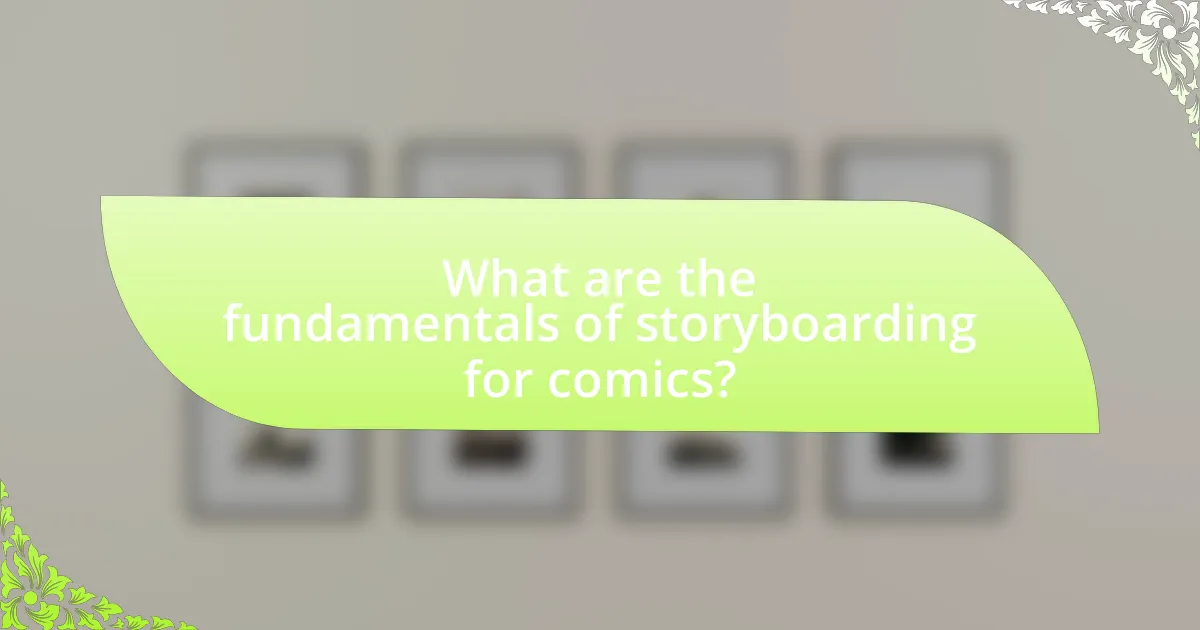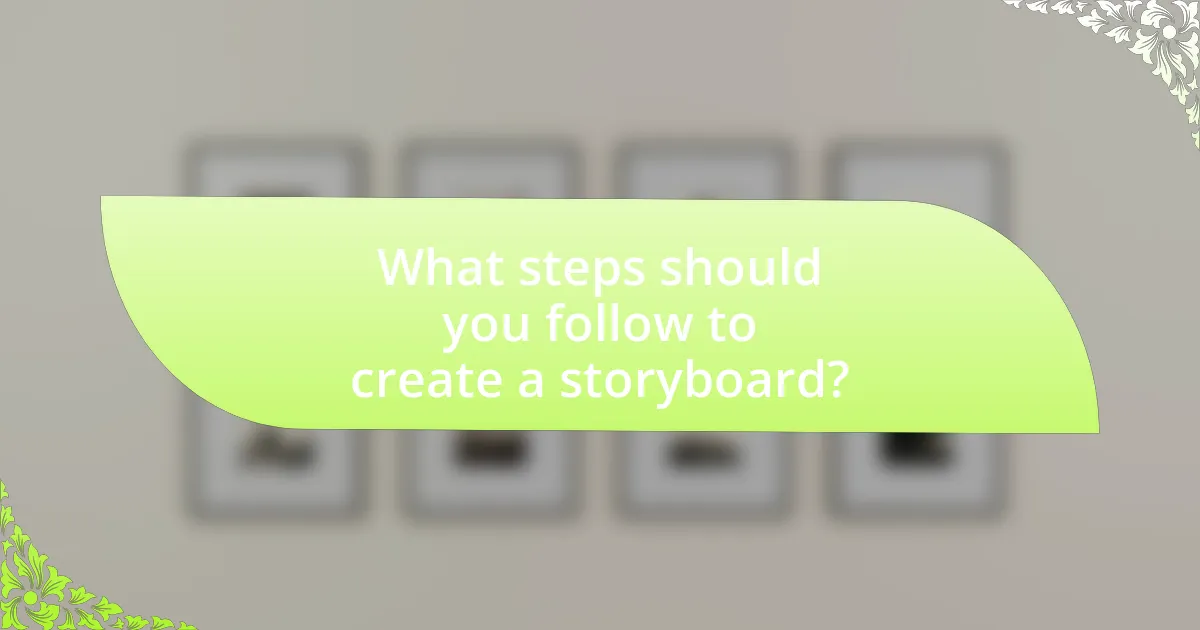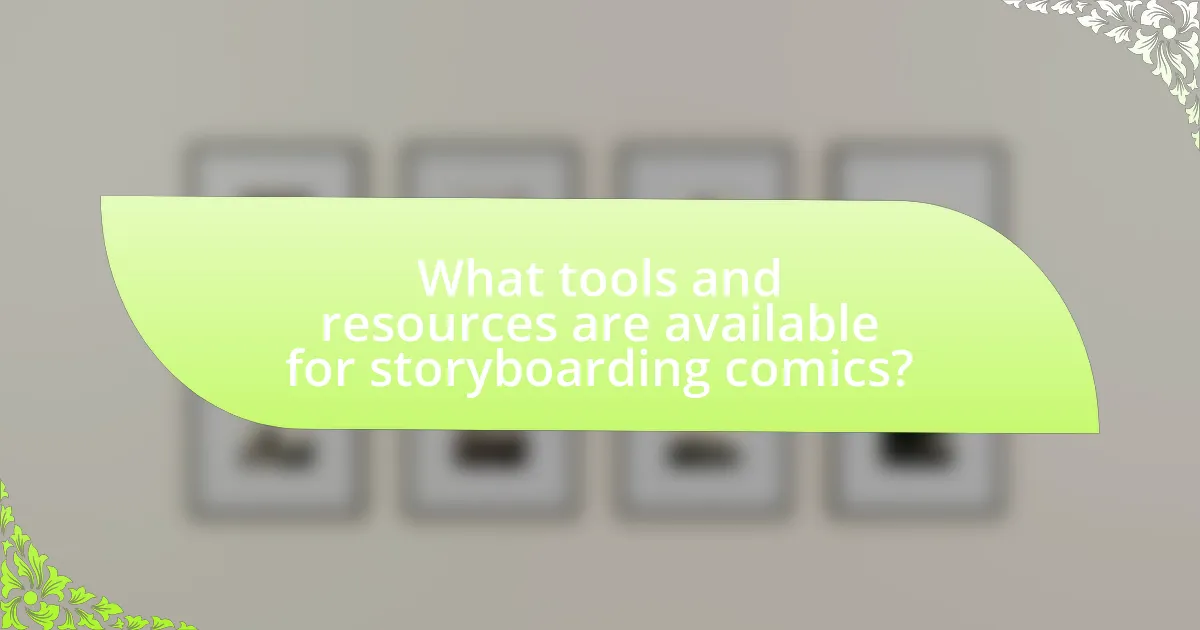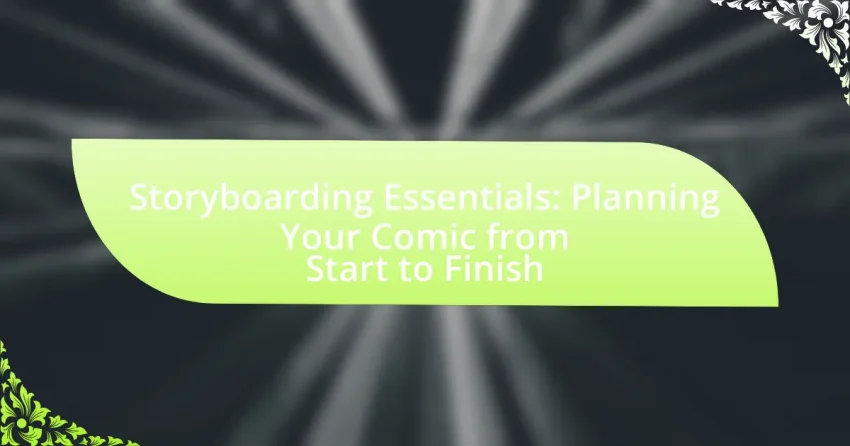The article “Storyboarding Essentials: Planning Your Comic from Start to Finish” focuses on the critical role of storyboarding in comic creation. It outlines the fundamentals of storyboarding, including visualizing narratives, organizing panels, and establishing pacing, which are essential for effective storytelling. Key elements of a successful storyboard, such as character development and scene composition, are discussed, along with the importance of planning to enhance narrative coherence and reader engagement. The article also covers techniques for layout, tools available for storyboarding, common mistakes to avoid, and best practices to improve clarity and effectiveness in the storyboard process.

What are the fundamentals of storyboarding for comics?
The fundamentals of storyboarding for comics include visualizing the narrative, organizing panels, and establishing pacing. Visualizing the narrative involves creating a clear sequence of events that conveys the story effectively. Organizing panels requires determining the layout and flow of images and text to guide the reader’s eye, ensuring that each panel transitions smoothly to the next. Establishing pacing is crucial for controlling the rhythm of the story, which can be achieved through the size and arrangement of panels, as well as the timing of dialogue and action. These elements work together to create a cohesive and engaging comic that resonates with readers.
How does storyboarding enhance the comic creation process?
Storyboarding enhances the comic creation process by providing a visual blueprint that organizes narrative flow and pacing. This structured approach allows creators to map out scenes, ensuring that each panel effectively conveys the intended story elements and emotional beats. Research indicates that storyboarding can reduce production time by up to 30%, as it helps identify potential issues early in the creative process, allowing for adjustments before final artwork is executed. By visualizing the comic’s progression, artists can maintain consistency in character design and settings, ultimately leading to a more cohesive and engaging final product.
What are the key elements of a successful storyboard?
The key elements of a successful storyboard include clear visual representation, a coherent narrative flow, character development, and scene composition. Clear visual representation ensures that each frame effectively communicates the intended action or emotion, allowing viewers to easily understand the story. A coherent narrative flow maintains logical progression, guiding the audience through the plot without confusion. Character development is crucial, as it provides depth and relatability, making the audience invested in the characters’ journeys. Scene composition involves the arrangement of elements within each frame, including backgrounds, props, and character positioning, which enhances storytelling by creating visual interest and context. These elements collectively contribute to a storyboard’s effectiveness in conveying a story.
How does a storyboard influence pacing and flow in comics?
A storyboard influences pacing and flow in comics by visually organizing the sequence of panels and scenes, which dictates the rhythm of the narrative. By determining the arrangement and timing of each panel, a storyboard helps to control how quickly or slowly the story unfolds, allowing for moments of tension or relief. For instance, a series of tightly arranged panels can create a fast-paced action sequence, while larger, more spaced-out panels can emphasize a dramatic moment, giving readers time to absorb the impact. This structured approach to visual storytelling ensures that the intended emotional beats and narrative arcs are effectively communicated, enhancing the overall reading experience.
Why is planning essential before starting a comic?
Planning is essential before starting a comic because it establishes a clear narrative structure and visual direction. A well-defined plan helps creators outline the plot, develop characters, and determine pacing, which are crucial for maintaining reader engagement. Research indicates that comics with a structured storyboard are more coherent and enjoyable, as they allow for better visual storytelling and pacing. For instance, a study published in the Journal of Graphic Novels and Comics highlights that comics with thorough planning tend to have higher reader satisfaction ratings, demonstrating the importance of preparation in the creative process.
What are the risks of skipping the planning phase?
Skipping the planning phase in comic storyboarding can lead to significant risks, including disorganization, unclear narrative flow, and wasted resources. Without a structured plan, creators may struggle to maintain coherence in the storyline, resulting in plot holes or inconsistencies that confuse the audience. Additionally, the absence of a clear vision can lead to inefficient use of time and materials, as artists may need to redo work that could have been avoided with proper planning. Historical examples in the comic industry show that projects lacking a solid planning phase often face delays and increased costs, ultimately affecting their success and reception.
How can effective planning improve storytelling in comics?
Effective planning enhances storytelling in comics by providing a structured framework that guides narrative development and visual composition. This structured approach allows creators to outline plot points, character arcs, and pacing, ensuring that each element contributes to a cohesive story. For instance, a well-defined storyboard can help identify key scenes and transitions, which improves the flow of the narrative and maintains reader engagement. Research indicates that comics with clear planning often exhibit stronger character development and thematic consistency, as seen in successful series like “Watchmen” and “Maus,” where meticulous planning contributed to their critical acclaim.

What steps should you follow to create a storyboard?
To create a storyboard, follow these steps: first, define the concept and purpose of your story. This involves outlining the main plot points and identifying the target audience. Next, break down the story into scenes or panels, ensuring each one conveys a specific moment or action. After that, sketch rough visuals for each scene, focusing on composition and character placement. Then, add dialogue and captions to clarify the narrative. Finally, review and revise the storyboard for coherence and flow, ensuring it effectively communicates the intended story. These steps are essential for organizing visual storytelling and enhancing the overall narrative structure.
How do you develop a concept for your comic?
To develop a concept for your comic, start by identifying the core theme or message you want to convey. This foundational idea guides the narrative and character development. Next, create a detailed outline that includes character arcs, plot points, and settings, ensuring each element supports the central theme. Researching existing comics and genres can provide inspiration and help refine your concept. For instance, analyzing successful comics like “Watchmen” or “Maus” reveals how strong themes and character development enhance storytelling.
What questions should you ask when brainstorming ideas?
When brainstorming ideas for storyboarding a comic, ask questions such as: What is the central theme or message of the comic? Who are the main characters, and what are their motivations? What is the setting, and how does it influence the story? What are the key plot points or events that drive the narrative? How does the story begin, develop, and conclude? These questions help clarify the direction and structure of the comic, ensuring a cohesive and engaging storyline. Research indicates that structured brainstorming techniques, including targeted questioning, enhance creativity and idea generation, making the process more effective.
How can character development influence your storyboard?
Character development significantly influences your storyboard by shaping the narrative structure and emotional arcs within the comic. Well-defined characters drive plot progression, as their motivations and growth dictate key events and interactions. For instance, a character’s transformation from a timid individual to a confident leader can create pivotal moments that enhance tension and engagement in the storyboard. This alignment between character evolution and story events ensures that the visual representation remains coherent and impactful, ultimately guiding the audience’s emotional response.
What techniques can be used to layout a storyboard?
Techniques used to layout a storyboard include thumbnail sketches, grid layouts, and digital tools. Thumbnail sketches allow for quick visualization of scenes and pacing, enabling creators to experiment with composition and flow efficiently. Grid layouts provide a structured approach, helping to maintain consistency in panel sizes and spacing, which is crucial for readability. Digital tools, such as storyboard software, facilitate easy adjustments and collaboration, allowing for the integration of visual elements and annotations. These techniques enhance the clarity and effectiveness of storytelling in comics.
What are the different formats for storyboarding a comic?
Different formats for storyboarding a comic include thumbnail sketches, digital storyboards, and script-based storyboards. Thumbnail sketches are small, rough drawings that outline the sequence of panels and key actions, allowing for quick visualization of the story flow. Digital storyboards utilize software to create detailed layouts, incorporating elements like dialogue and pacing, which can be easily edited. Script-based storyboards present the comic’s narrative in a written format, detailing panel descriptions and dialogue, which can help in organizing the story before visual representation. Each format serves a unique purpose in the planning process, facilitating the transition from concept to final artwork.
How do you decide on panel arrangement and composition?
Panel arrangement and composition are decided based on the narrative flow and visual impact of the comic. Effective storytelling requires a layout that guides the reader’s eye through the sequence of events, ensuring clarity and engagement. For instance, using larger panels for key moments emphasizes their importance, while smaller panels can convey quick actions or transitions. Additionally, the rule of thirds can be applied to create balanced compositions that draw attention to focal points. Research indicates that visual hierarchy significantly influences reader comprehension and emotional response, supporting the need for thoughtful panel design in storytelling.

What tools and resources are available for storyboarding comics?
Various tools and resources are available for storyboarding comics, including digital software, traditional materials, and online platforms. Digital tools like Clip Studio Paint, Adobe Photoshop, and Storyboard Pro offer features specifically designed for comic artists, such as panel layouts and drawing aids. Traditional materials include sketchbooks, pencils, and markers, which allow for hands-on creativity. Online resources like storyboard templates, tutorials, and forums provide guidance and community support for artists. These tools and resources enhance the storyboarding process, enabling creators to visualize and organize their narratives effectively.
What software options are best for digital storyboarding?
The best software options for digital storyboarding include Storyboard Pro, Toon Boom, and Adobe Photoshop. Storyboard Pro is widely recognized for its comprehensive features tailored for animators and filmmakers, allowing users to create detailed storyboards with ease. Toon Boom offers robust tools for animation and storyboarding, making it a preferred choice for professionals in the animation industry. Adobe Photoshop, while primarily an image editing software, is also utilized for storyboarding due to its versatility and extensive drawing capabilities. These software options are validated by their popularity and extensive use in the industry, demonstrating their effectiveness in facilitating the storyboarding process.
How do traditional methods compare to digital tools?
Traditional methods of storyboarding, such as hand-drawing on paper, offer tactile engagement and a direct connection to the creative process, while digital tools provide efficiency, flexibility, and ease of editing. Traditional methods allow artists to physically manipulate materials, fostering a unique artistic expression, but they often lack the speed and convenience of digital platforms. Digital tools, like software applications, enable quick revisions, layering, and integration of multimedia elements, which can enhance storytelling. According to a survey by the International Journal of Arts and Technology, 75% of artists reported that digital tools significantly improved their workflow efficiency compared to traditional methods.
What resources can help improve your storyboarding skills?
Books such as “Storyboarding Essentials” by David Harland Rousseau and Benjamin Reid Phillips provide comprehensive guidance on storyboarding techniques. Online courses from platforms like Skillshare and Udemy offer structured learning paths with practical exercises. Additionally, software tools like Storyboard Pro and Canva facilitate the creation of storyboards, allowing for hands-on practice. These resources collectively enhance understanding and application of storyboarding skills, supported by industry standards and expert insights.
What common mistakes should you avoid in storyboarding?
Common mistakes to avoid in storyboarding include neglecting to plan the flow of the narrative, failing to consider pacing, and not utilizing visual storytelling effectively. Planning the flow is crucial as it ensures that the story progresses logically and engages the audience. Pacing affects how the audience experiences the story; too fast can confuse, while too slow can bore. Additionally, visual storytelling should complement the narrative; relying solely on text can diminish the impact of the visuals. These mistakes can lead to a disjointed and ineffective storyboard, ultimately hindering the overall storytelling process.
How can overcomplicating your storyboard hinder your project?
Overcomplicating your storyboard can hinder your project by creating confusion and inefficiency in the creative process. When a storyboard is overly detailed or complex, it can lead to miscommunication among team members, resulting in inconsistent interpretations of the narrative. Research indicates that clear and concise storyboards enhance collaboration and streamline production, as seen in the work of filmmakers who prioritize simplicity in their visual planning. Additionally, excessive complexity can overwhelm creators, causing delays and reducing overall productivity, as they may struggle to navigate through convoluted visuals and ideas.
What are the signs of a poorly planned storyboard?
Signs of a poorly planned storyboard include lack of clarity in visual flow, inconsistent character design, and insufficient scene transitions. A storyboard that fails to convey a coherent narrative often results in confusion for the audience, as the sequence of events may be jumbled or unclear. Inconsistent character design can lead to a disjointed visual experience, making it difficult for viewers to connect with the characters. Additionally, inadequate scene transitions can disrupt the pacing of the story, causing abrupt shifts that detract from the overall engagement. These elements collectively indicate that the storyboard lacks the necessary planning and structure to effectively communicate the intended story.
What are some best practices for effective storyboarding?
Effective storyboarding involves several best practices that enhance clarity and communication. First, clearly define the narrative structure by outlining the beginning, middle, and end of the story, which helps in organizing the flow of events. Second, utilize visual consistency by maintaining a uniform style and layout throughout the storyboard, ensuring that characters and settings are easily recognizable. Third, incorporate annotations and notes to provide context for each panel, which aids in conveying the intended emotions and actions. Fourth, prioritize pacing by varying the size and arrangement of panels to control the rhythm of the story, allowing for moments of tension or relief. Lastly, seek feedback from peers or mentors during the process, as external perspectives can identify areas for improvement and enhance the overall effectiveness of the storyboard. These practices are supported by industry standards, such as those outlined in “The Visual Story” by Bruce Block, which emphasizes the importance of structure and visual coherence in storytelling.
How can feedback improve your storyboard’s effectiveness?
Feedback can significantly enhance your storyboard’s effectiveness by providing diverse perspectives that identify strengths and weaknesses. When creators receive constructive criticism, they can refine narrative clarity, pacing, and visual coherence, leading to a more engaging final product. Research indicates that peer reviews in creative processes can increase overall quality by up to 30%, as highlighted in studies on collaborative creativity. This process allows for iterative improvements, ensuring that the storyboard resonates with the intended audience and effectively communicates the story.
What tips can help maintain clarity and coherence in your storyboard?
To maintain clarity and coherence in your storyboard, use a consistent visual style and clear labeling for each panel. Consistent visual elements, such as character designs and color schemes, help the audience easily follow the narrative. Clear labeling, including scene descriptions and dialogue, ensures that the intended message is communicated effectively. Additionally, organizing panels in a logical sequence allows for a smooth flow of the story, making it easier for viewers to understand the progression of events. These practices are supported by the principles of visual storytelling, which emphasize the importance of clarity in conveying complex narratives.
